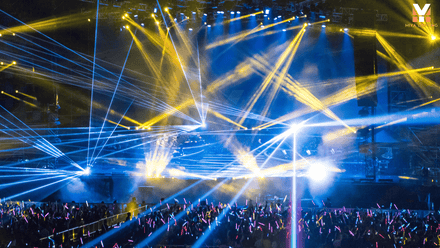Home /
How to Identify Concert Lasers and Avoid Damage to Your Equipment

Dec 23, 2024
2 minute read
Lasers at concerts are often a trending topic, especially when it comes to concerns about laser beams hitting phone or camera lenses and causing damage. Many concert-goers wonder how to avoid these risks and whether high-powered lasers can harm their devices. This article provides a comprehensive guide on identifying laser lights, distinguishing them from other stage lighting equipment, and protecting your devices effectively.
Not All Concert Lights Are Lasers!
First and foremost, it's important to understand that not all concert lights involve laser beams. Concerts use a variety of stage lighting equipment, and only specific lights are considered professional laser systems. Learning to distinguish laser lights from other types of concert lighting will help safeguard your gear.
PLasers vs. LED Beam Lights
Characteristics of High-Powered Lasers
Laser beams are distinct from traditional light beams due to their unique characteristics:

1.High Brightness: Laser lights produce intensely concentrated beams of light.
2.Pure Colors: The colors are vibrant, precise, and highly saturated.
3.High Energy: Laser beams carry enough energy to damage sensitive CMOS sensors in cameras and phones.
Lasers appear in the following forms at concerts:
1.Sheet-like Laser Effects: Thin, foggy layers of light.

2.Point Lasers: Single, highly concentrated points of light.

3.Scattered Dot Lasers: Multiple dots projected across a surface.

4.Laser Rain: Dense arrays of laser beams resembling rainfall—this is highly dangerous to devices. Amateur photographers should avoid filming these effects.

Characteristics of LED Beam Lights
Unlike lasers, LED beam lights produce softer, broader light beams. These are safe for cameras and pose no risk to CMOS sensors.
Examples:
Close-range LED beam lights: Completely safe for photography.

Mid-range and long-range beam lights: Also safe and commonly used in stage lighting equipment.

Strobe Lights

Strobe lights, commonly used in concerts, emit rapid flashes and are entirely harmless to camera sensors.
Where Do Laser Beams Originate During a Concert?
Concert lasers are typically installed as part of the professional laser systems used for stage lighting. These systems can be mounted in the following ways:
Suspended Lasers: Mounted above the stage for wide-angle coverage.
Floor-Mounted Lasers: Positioned on the stage floor to project beams upward or across the venue.
Lasers emit their beams through protective glass panels, ensuring smooth light projection without interference.
What Happens if a Laser Hits Your Device?
Permanent Damage to Devices
When a high-powered laser beam strikes a phone or camera, it can cause the following:
1.Lens Damage: While rare, extreme cases can affect the physical lens.
2.CMOS Sensor Damage: The CMOS sensor inside your device may develop “dead pixels” or lines that appear in all future photos and videos.

Real-World Test Results
In tests using a high-powered laser pointer directed at a smartphone lens, the lens was immediately damaged. The CMOS sensor, being more sensitive, is typically the first component affected.
How to Safely Capture Laser Effects
Some laser effects can be photographed safely, such as:
1.Lasers Directed Upward: Laser beams aimed into the sky pose minimal risk to devices.

2.Localized Laser Effects: As long as the beam doesn't hit your lens directly, shooting is safer.

However, full-range sweeping lasers, like "laser rain," are extremely risky. Avoid photographing or filming such effects to protect your equipment.

How to Avoid Laser Damage
Avoid Filming During Laser Effects
The simplest and safest approach is not to film when lasers are active.
Post-Processing Repairs
If damage occurs, "dead pixels" can sometimes be corrected in post-production. However, repairing every affected frame can be time-consuming and tedious.
Professional Repairs
In severe cases, the CMOS sensor may need replacement. For example, replacing the CMOS in a Sony A7M3 can cost between 2,000 and 3,000 RMB. Costs vary by brand but are generally expensive.
Which Areas Are Most at Risk?

High-Risk Zones: Seats directly facing the stage or at diagonal angles are most prone to laser exposure.
Lower-Risk Zones: Side seats or areas further from the stage are generally safer.
By carefully choosing your seating and avoiding direct laser exposure, you can significantly reduce the chances of damage to your camera or phone.
Conclusion
Concerts are breathtaking visual spectacles, with stage lighting equipment like laser lights, LED beam lights, and strobe effects enhancing the experience. However, high-powered lasers pose real risks to your devices, especially their sensitive CMOS sensors. Learning to identify laser beams, avoiding high-risk areas, and refraining from filming during intense laser effects are the best ways to protect your equipment. For non-professionals, the safest approach is to avoid capturing laser effects altogether, ensuring you enjoy the concert without risking costly damage.
